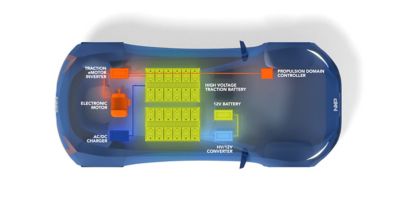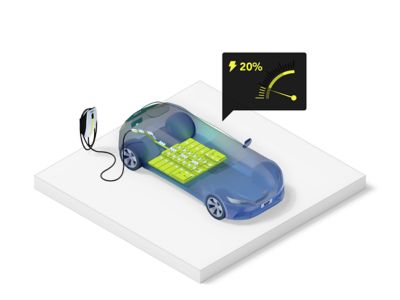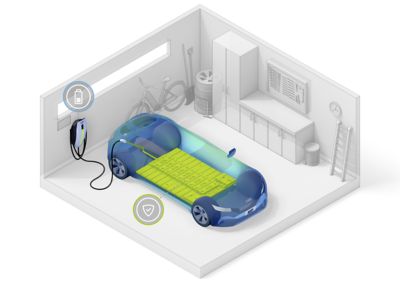-
United States -
United Kingdom -
India -
France -
Deutschland -
Italia -
日本 -
대한민국 -
中国 -
台灣
-
-
产品组合
查看所有产品Ansys致力于通过向学生提供免费的仿真工程软件来助力他们获得成功。
-
ANSYS BLOG
January 28, 2022
Ansys Streamlines NXP Semiconductors’ BMS Safety Analysis
Electric vehicle (EV) sales are surging thanks to the increasing global consciousness of consumers and automotive manufacturers alike. Tesla, in fact, began the new year by announcing fourth-quarter deliveries of more than 308,000 electric vehicles — approximately one-third of their total vehicle deliveries for 2021, shattering expectations on Wall Street. To provide some perspective, Tesla electric vehicle deliveries for all of 2020 amounted to just under 500,000.
While enthusiasm for these vehicles is clearly growing, EVs come with a unique set of safety challenges. Battery management is critical, as the internal cell failure of just a single automotive battery cell can cause a large-scale thermal runaway event in an electric vehicle. In response, EV manufacturers are maintaining a laser-sharp focus on safety, and they’re looking to battery management system (BMS) suppliers to help them accomplish their objectives. Using Ansys medini analyze, NXP Semiconductors is leading the charge in battery management system development to exceed customer expectations for safety.

NXP takes a top-down approach to establishing the safety functionality of their battery management systems.
NXP Semiconductors N.V. is a Dutch multinational semiconductor manufacturer with headquarters in Eindhoven, Netherlands. The company’s automotive solutions encompass complex autonomy, connectivity, and electrification challenges. On the electric powertrain front, NXP helps provide scalable and safe solutions that reduce overall cost, extend the range, and accelerate EV system development.
Electric Thermal Runaway in EV Applications
Electric vehicle thermal runaway events, despite their infrequency, have definitely captured the attention of automotive manufacturers. Electric vehicle functionality is supported by a sophisticated matrix of advanced driver assistance systems linked to autonomy and electrification, but lithium-ion battery power enables them all. By their very nature, lithium-ion batteries are complex, unstable components consisting of several cells that require constant monitoring. They have a higher energy density than other battery chemistries do, enabling lighter, smaller EV battery designs. However, this difference in energy density can also impact the thermal stability of the batteries, making them extremely combustible under certain conditions. With so much at stake, battery health is critical to the safety and functionality of electric vehicles. Battery management systems play an outsized role in achieving this objective.
Temperature control is critical in lithium-ion automotive applications. If batteries are not leveled properly, they can burn. NXP battery management systems monitor and control the lithium-ion cell parameters of the battery to mitigate risk of burn. These parameters include the cell voltage, cell temperature, over energy flow of the cell, as well as overall state of charge, state of health, and state of function of the battery. NXP offers a variety of BMS hardware and software components, including battery cell controllers and the respective SW drivers for 14V, 48V, and high voltage batteries. All of the components require full traceability from established safety goals to failure. The sheer complexity of these applications requires specific tool support to conduct a thorough analysis.

NXP battery management systems monitor and control the lithium-ion cell parameters of the battery
“As a semiconductor company, we have to proactively make assumptions about safety characteristics of our battery management systems to help prevent thermal runaway, whether a vehicle is on the road or left unattended charging,” says Markus Hafermalz, System Architect, Functional Safety for the BMS group at NXP Semiconductors. “Medini analyze supports best-practice workflows that graphically link specific areas of the semiconductor design to key functions within the electronics architecture. This allows us to analyze and address potential failure modes as we verify the functional safety of the semiconductor components.”
Supporting Automotive Safety Requirements
NXP takes a top-down approach to establishing the safety functionality of their battery management systems. Thanks to medini analyze, the process is seamless: NXP can import their design, identify missing requirements, and propose improvements with the help of a single tool. Medini analyze allows for consistent and efficient application of industry guidelines like ISO 26262, alleviating any systemic fault while providing an entire flow relevant to the infrastructure required for NXP’s base product configurations. NXP’s process begins with a requirements document, then drills down to more detail, taking into consideration existing system architecture and technical safety requirements to further define safety. From there, the document is imported into medini analyze, enabling the engineering team to test for system malfunctions, derive safety mechanisms for events uncovered during fault tree analysis, then derive safety requirements. The entire trace is done automatically in medini analyze to system requirement specifications.

Safety is a key characteristic of NXP’s battery management systems
“Unlike other tools we have used in the past, medini analyze offers built-in check points and validation features we rely on during our analysis,” says Kavya Prabha Divakarla, Automotive Systems Functional Safety Architect/Manager at NXP. “When building a fault tree analysis, for example, if certain connections are not made correctly, the software does not let us execute the tree. Through design checks and other checkpoints in the tool, we can confidently verify the entire chip has been mapped correctly.”
Once all safety requirements are defined, NXP engineers export the information to model BMS functional system architecture, before importing the completed model back into medini analyze for further analysis. Medini analyze enables NXP to allocate established technical safety requirements to the various system elements, as well as the import of NXP’s failure mode catalog as a separate hardware model. The software helps establish consistency between the failure mode catalog and hardware model to annotate numerous failure modes quickly. With Ansys software and support, NXP engineers can efficiently and consistently execute safety-related activities such as Failure Mode Effect and Diagnostic Analysis (FMEDA) to obtain product failure rates required by safety standards like ISO 26262, an automotive functionality safety standard.
“Before using medini analyze, linking the process with our safety model was tedious and time consuming,” says Dr. Franck Galtié, Functional Safety Fellow, Central Technical Office at NXP Semiconductors. “With medini analyze we are able to reduce that effort significantly, with fewer errors. The program also gives us previous chip data from multiple safety applications we can use to build one safety analysis, configuration, and project. Compiling this information into one file results in a single gold source, making it easier from a verification and review perspective for a plug-and-play type of engineering.”
Discover how medini analyze is helping manufacturers to streamline automotive safety analysis.










